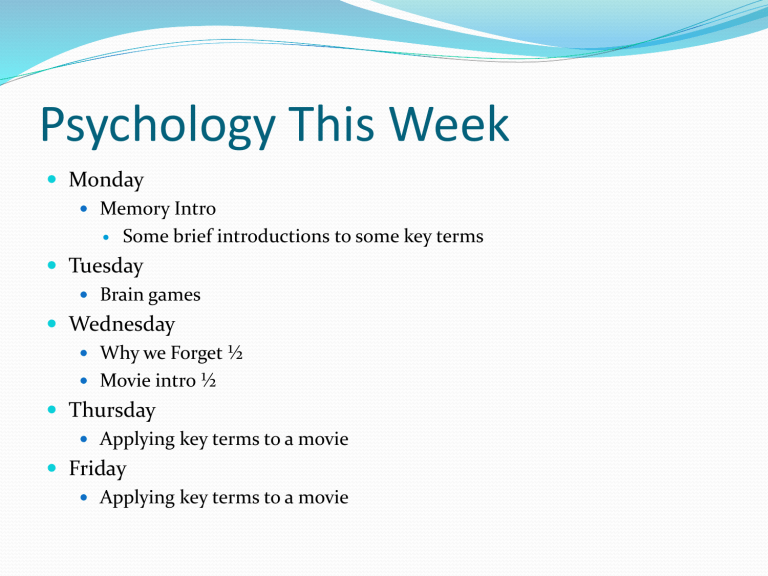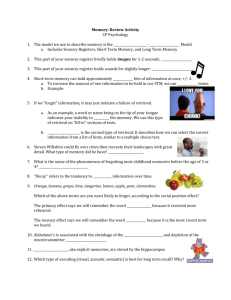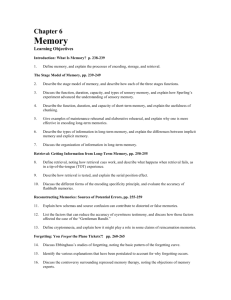Long-term memory - Bremen High School District 228
advertisement

Psychology This Week Monday Memory Intro Some brief introductions to some key terms Tuesday Brain games Wednesday Why we Forget ½ Movie intro ½ Thursday Applying key terms to a movie Friday Applying key terms to a movie Psychology Today Monday 12/5/11 Memory games Memory Terms What is memory? What are the processes of memory? What are the types of memory? SM STM LTM Before you Leave What are the 3 Stages of memory? What are the three types of memory? What are the 3 types of long term memory? Exploring Memory The USA National Memory Championship World Records of Memory 1. Memorize 99 names and faces in 15 min. 2. Memorize an unpublished poem of 50 lines in 15 min. 3. Memorize a list of 500 random numbers 4. Memorize a list of 500 random words 5. Memorize the order of a deck of cards in 1 minute 20 Seconds on The Clock Activity 1--You have 20 sec. to memorize the names and faces Frank Dan Sarah Jenny Amy Megan Brandon Andrew Nora Julian Andrew Julian Megan Jenny Brandon Amy Frank Dan Sarah Nora 1. Nora 2. Andrew 3. Jenny 4. Sarah 5. Dan 6. Julian 7. Brandon 8.Amy 9. Frank 10. Megan Activity 2--SPOT THE REAL PENNY (A) Oh, say, can you see, by the dawn's early light, What so proudly we hailed at the twilight's last gleaming? Whose broad stripes and bright stars, thro' the perilous fight' O'er the ramparts we watched, were so gallantly streaming. And the rockets red glare, the bombs bursting in air, Gave proof through the night that our flag was still there. Oh, say, does that star-spangled banner yet wave O'er the land of the free and the home of the brave? The National Anthem --What so proudly we hailed at the twilight's last gleaming? --Whose broad stripes and bright stars, thro' the perilous fight' What line comes before this? The National Anthem --Oh, say, can you see, --By the dawn's early light, The National Anthem --O'er the ramparts we watched, were so gallantly streaming. --And the rockets red glare, the bombs bursting in air, What about this? The National Anthem --What so proudly we hailed at the twilight's last gleaming? --Whose broad stripes and bright stars, thro' the perilous fight' Questions to Ponder Activity 1- Names w/faces What made this task difficult? Why? People you never met? Skin color? Attractiveness? Order of faces were switched? Not enough time? Activity 2- Spot the Penny What made this task difficult? You’ve seen thousands of them Activity 3 What made this task so difficult? You’ve sang the song thousands of time. Did you forget the words? The Point Memory Facts Memories are never completely perfect Even with rehearsal long term and short term memories can be filled with gaps Memories don’t last forever Even long term memories fade and die with time Memories have life expectancies Memory isn’t infinite The average human can store up to 300,00 facts Studies have shown memory overload may cause Alzheimer's Human memory is meant to work in specifically trained orders assisted by memory cues We learn and remember tasks from start to finish Memory cues like rhyming and mnemonic devices strengthen memory for easier recall The Biology of Memory We are still learning about the role of the brain in MEMORY. To what extent the brain is involved is still being determined. Memory The persistence of learning over time through the storage and retrieval of information. Encoding Converting information into a usable form in which it will be retained in memory Typing info into a computer Getting a girls name at a party Storage The storing of encoded material over time. Pressing Ctrl S and saving the info. Trying to remember her name when you leave the party. Retrieval The process of getting the information out of memory storage. Finding your document and opening it up. Seeing her the next day and calling her the wrong name (retrieval failure). Information-Processing Theory Sensory information STORAGE economics literature Encoding RETRIEVAL Information is taken into brain Information is used as basis of behaviors and interactions culture science religion history math Information gets processed, analyzed, and stored until use Information-Processing Model of Memory Computer as a model for our memory Three types of memory Sensory memory Short-term memory (STM) Long-term memory (LTM) Can hold vast quantities of information for many years Three-Stage Process of Memory Sensory memory (selective attention) (lost after 1-2 sec.) Sensory memory (lost after 15-30 sec.) Short-term (selective attention) memory Hear a song on the radio Sensory memory Short-term memory (repetition) You remember the chorus for about 30 sec. after the song is over (selective attention) Short-term memory See a billboard driving home that reads, “if you visit www.freestuff.com, you will get a free iPod” You remember the website link for about 30 sec. after you drive by the billboard Long-term memory (indefinite unless decay) Long-term (repetition) memory listen to the song 18 more times (repetition) You remember all of the lyrics Long-term memory the website is repeated in your head all day but soon forget ? Sensory Memory -- works as a filter. It allows us time to determine what to pay attention to. Sensory Memory Stores all the stimuli that register on the senses Lasts up to three seconds Sensory Input Sensory Memory Two types Iconic memory Visual Usually lasts about 0.3 seconds Sperling’s tests (1960s) Echoic memory Auditory Usually fades within 2-3 sec Testing the Sensory Memory 2 N L 8 5 Q F 7 4 3 6 K Testing the Sensory Memory 2 N L 8 5 Q F 7 4 3 6 K George Sperling’s Experiment (1960) Presented matrix of letters for 1/20 seconds Report as many letters as possible Subjects recalled only half of the letters Was this because subjects didn’t have enough time to view entire matrix? No How did Sperling know this? Sperling’s Iconic Memory Experiment Sperling’s Iconic Memory Experiment Sperling’s Iconic Memory Experiment Sperling’s Iconic Memory Experiment Sperling’s Experiment Sounded low, medium or high tone immediately after matrix disappeared Tone signaled 1 row to report Recall was almost perfect Memory for images fades after 1/3 seconds or so, making report of entire display hard to do High Medium Low Short-term Memory Function Conscious processing of information Attention is the key Limits what info comes under the spotlight of shortterm memory at any given time AKA working memory Sensory Input Sensory Memory Attention Working or Short-term Memory Selective Attention: the ability to focus on ONLY one stimulus from among all other incoming information The key to short term memory Key idea: We filter out distractions that we deem unnecessary or unimportant A (often unconsciously) to lighten our memory load C D B “cocktail party effect” What if our “selective attention” is divided btw tasks? Focusing on multiple stimuli may result in memory loss B has to keep a conversation with A, but at the same time listen to the conversation between C and D A C B must REMEMBER the details of both conversations D B Memorize the following list of numbers: 18121941177614922001 Write down the numbers in order. Now, try again… 1812 1941 1776 1492 2001 How to Strengthen Your STM How? Maintenance rehearsal The use of repetition to keep info in short-term memory CHUNK A solid, meaningful unit of information Mnemonic Devices = Techniques for using associations to memorize and retrieve information Short-term Memory Limited capacity Can hold 7 ± 2 items for about 20 seconds How? Maintenance rehearsal The use of repetition to keep info in short-term memory CHUNK A solid, meaningful unit of information Without rehearsal, we remember 4 ± 2 chunks With rehearsal, we remember 7 ± 2 chunks Ericsson & Chase (1982) 893194434925021578416685061209488885687727314186105 46297480129497496592280 Short-Term or Working Memory Use it or lose it!!!!! Working with information….. Mnemonic Devices = Techniques for using associations to memorize and retrieve information Demonstration Attend to the words in the green box as they flash on the screen. When the last word disappears, write down as many words as you can recall. TABLE SNOW FOOT DOG SON END HAT BUS BREAD DOOR CAT Encoding-Serial Position Effect Percentage of words recalled 90 80 70 60 50 40 30 20 10 0 1 2 3 4 5 6 7 8 9 Position of word in list 10 11 12 Long-term Memory Once information passes from sensory to short-term memory, it can be encoded into long-term memory Retrieval Sensory Input Attention Sensory Memory Working or Short-term Memory Encoding Long-term memory Long-term memory: the system of memory into which all the information is placed to be kept more or less permanently LTM at Tinley Park High School Questions What was your class schedule freshman year? What period did you have lunch sophomore year? What did you wear your first day of high school? What was your old locker # and combination #? Types of Long-term memory (1) Procedural (Implicit) Memories of behaviors, skills, etc. Demonstrated through behavior (2) Declarative (Explicit) Memories of facts Episodic – personal experiences tied to places & time Semantic – general knowledge Semantic network Explicit Memories (aka, declarative memories) Episodic Memories Semantic Memories Formed by the hippocampus; stored in the cerebral cortex. Implicit Memories Procedural Memories Conditioned Memories Formed by the cerebellum; stored in the cerebral cortex. Long-term memory The Encoding Process Elaborative rehearsal A technique for transferring information into long-term memory by thinking about it in a deeper way Levels of processing Semantic is more effective than visual or acoustic processing Craik & Tulving (1975) Self-referent effect By viewing new info as relevant to the self, we consider that info more fully and are better able to recall it To summarize…. Semantic Networks Bus Truck Ambulance Orange House Fire Engine Fire Yellow Green Red Apples Cherry Roses Sunrise Daisies Flowers Sunsets Clouds Retrieval Retrieval Process that controls flow of information from long-term to working memory store Explicit memory The types of memory elicited through the conscious retrieval of recollections in response to direct questions Implicit memory A nonconscious recollection of a prior experience that is revealed indirectly, by its effects on performance Retrieval – Explicit Memory Free-recall test A type of explicit memory task in which a person must reproduce information without the benefit of external cues Recognition task A form of explicit memory retrieval in which items are presented to a person who must determine if they were previously encountered Retrieval failure Tip-of-the-tongue (Brown & McNeill) Retrieval – Explicit Memory Context-Dependent Memory We are more successful at retrieving memories if we are in the same environment in which we stored them State-Dependent Memory We are more successful at retrieving memories if we are in the same mood as when we stored them Retrieval – Implicit Memory Showing knowledge of something without recognizing that we know it Research with amnesics Déjà vu The illusion that a new situation is familiar Eyewitness testimony Eyewitness transference Unintentional plagiarism Forgetting If we remembered everything, we should on most occasions be as ill off as if we remembered nothing. William James Lack of encoding Often, we don’t even encode the features necessary to ‘remember’ an object/event Decay Memory traces erode with the passage of time No longer a valid theory of forgetting Jenkins & Dallenbach (1924) Forgetting Sensory memory - the senses momentarily register amazing detail Short term memory - a few items are both noticed and encoded Long-term storage - Some items are altered or lost Retrieval from long-term memory depending on interference, retrieval cues moods and motives, some things get retrieved, some don’t Information bits Theories of Forgetting Decay theory- Memory trace fades with time Encoding Failure: May contribute to information never being encoded from STM to LTM and thus forgotten. Retrieval failure The information is still within LTM, but cannot be recalled because the retrieval cue is absent © 2004 John Wiley & Sons, Inc. Huffman: PSYCHOLOGY IN ACTION, 7E Interference theory Forgetting is a result of some memories interfering with others Proactive interference Old memories interfere with ability to remember new memories Retroactive interference New memories interfere with ability to remember old memories Interference is stronger when material is similar Forgetting Repression There are times when we are unable to remember painful past events While there is no laboratory evidence for this, case studies suggest that memories can be repressed for a number of years and recovered in therapy Memories of Abuse Repressed or Constructed? Child sexual abuse does occur Some adults do actually forget such episodes Ebbinghaus’s Forgetting Curve This graph dramatizes how rapidly nonsense syllables are forgotten, especially in the first few hours after learning. © 2004 John Wiley & Sons, Inc. Huffman: PSYCHOLOGY IN ACTION, 7E Memory Construction We filter information and fill in missing pieces Misinformation Effect incorporating misleading information into one's memory of an event Source Amnesia attributing to the wrong source an event that we experienced, heard about, read about, or imagined (misattribution) Memory Construction- Loftus and Palmer (1974) Depiction of actual accident Eyewitnesses reconstruct memories when questioned Leading question: “About how fast were the cars going when they smashed into each other?” Memory construction Movie Time! Memento Children’s Testimony If asked if a visitor committed acts that had not occurred, few 4-6 year olds said yes. 30% of 3-year olds said yes When investigators used techniques taken from real child-abuse investigations, most children said yes. Norris Edwards: Chapter 1: Wade01.ppt Page: 72 Social Pressure, False Allegations Reasons to Forget Retrograde Amnesia Brain damage to the hippocampus that results in inability to remember events that happened before the event Anterograde Amnesia Brain damage to the hippocampus that results in the inability to form new memories 50 first dates? Memory Construction Schema theory Preconceptions about persons, objects, or events that bias the way new information is interpreted and recalled Misinformation effect The tendency to incorporate false postevent information into one’s memory of the event itself Illusory memories People sometimes create memories that are completely false • Eyewitness Testimony • It is often wrong • Involves recognition • Memory of event is often distorted • Eyewitnesses can be misled by questioning • Distortion: Misremembering because of bias or suggestibility • College students remembered 89% of their high school “A” grades but only 29% or “D” grades. • With eyewitness testimony, suggestibility can cause an incorrect identification as in cases where people were convicted and later freed as a result of DNA evidence. • Divorcing couples FORGETTING Types Decay – fading away of memory over time Amnesia – loss of memory as a result of a blow to head or brain damage. Other causes: Stress/Drugs Interference – blockage of a memory by previous or subsequent memories or loss of a retrieval cue •Proactive Interference: prior learning interferes with learning new information • Retroactive Interference: newly learned information interferes with previously learned information Repression – pushing the memory of a threatening or traumatic event deep into the unconscious DID YOU KNOW! Flashbulb Memories are vivid recollections of events that are shocking or emotional DID YOU KNOW! The SQ3R method of studying improves your ability to recognize and recall information Improving Memory Pg. 276 new book INTELLIGENCE: IQ & TESTING • PSYCHOMETRICS - subarea of psychology concerned with developing tests to assess abilities, skills, beliefs, traits, etc. INTELLIGENCE The ability to acquire new ideas and new behavior, and to adapt to new situations. Different views on Intelligence exist Emotional Intelligence: The ability to perceive, use, understand, and regulate emotions. Two-Factor Theory: Intelligence includes a general ability (g) level and specific mental abilities (s) Gardner’s Multiple Intelligence Theory: Numerous (8) and unrelated intelligences INTELLIGENCE TEST Measure IQ, or a standardized measure of intelligence based on a scale of which 100 is average Stanford-Binet Intelligence Scale: • Originally meant for children; adapted for adults • Groups test items by age level • 100 is average for given age Wechsler Tests: • More common today • Three versions (2-6, 6-16, 16-89) •More detailed scoring •Normal Distribution - The distribution of scores (commonly called IQ scores) on the Wechsler Adult Intelligence Scale follows an approximately normal curve, an average distribution of values. The test is regularly adjusted so that the median score is 100— that is, so that half of the scores fall above 100, and half fall below. IQ SCORES – What do they mean? Average score is 100 Traditionally 70 or below = mentally handicapped Good indicator of success in school Do not predict success in the real world Nature v. Nurture: Both genetic factors & the environment play a role in IQ. The % each contributes is debatable. Cultural Bias: wording used in questions may be more familiar to people or one social group than to another group Illinois State Police








